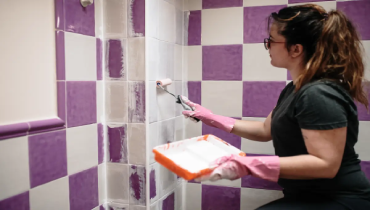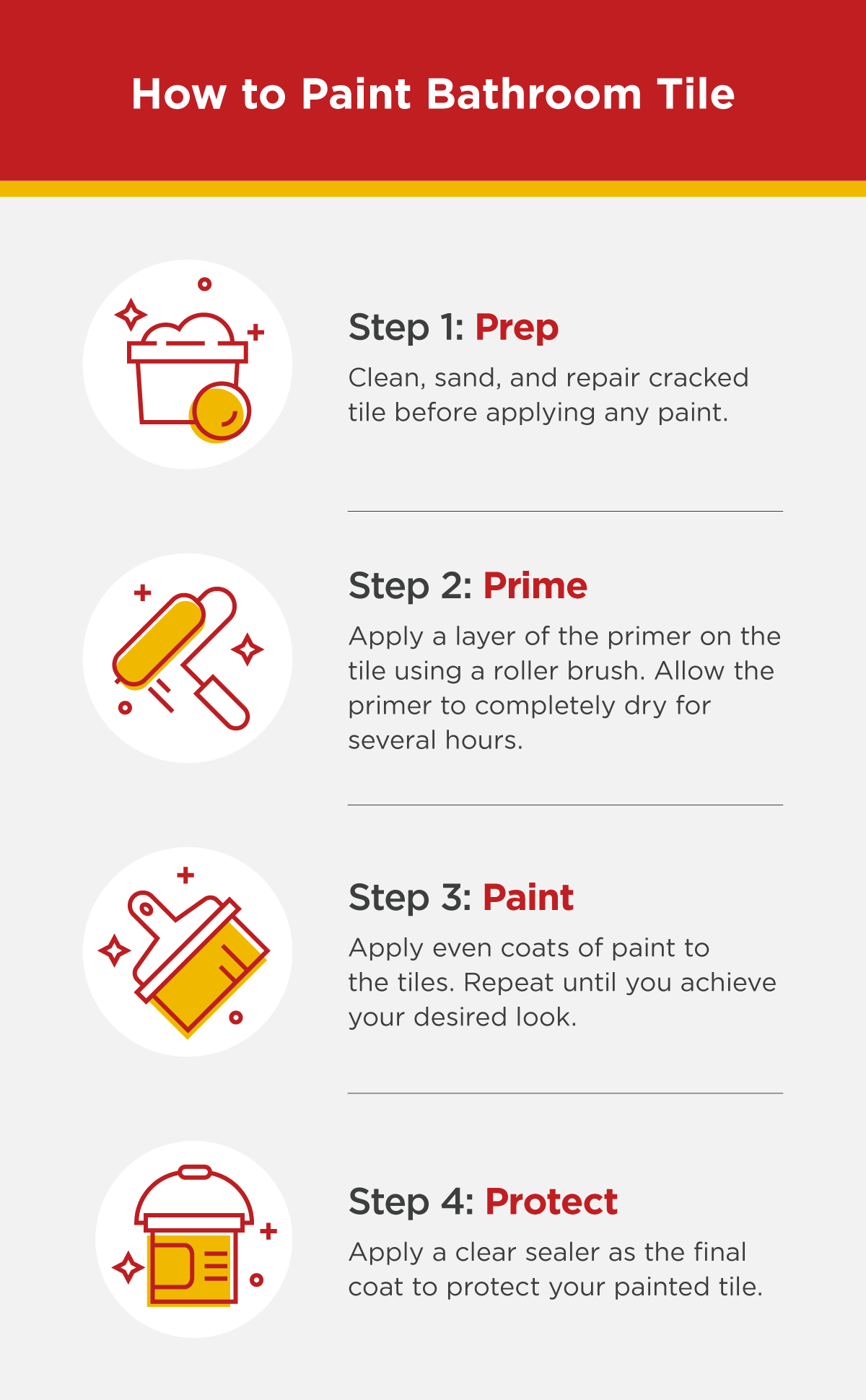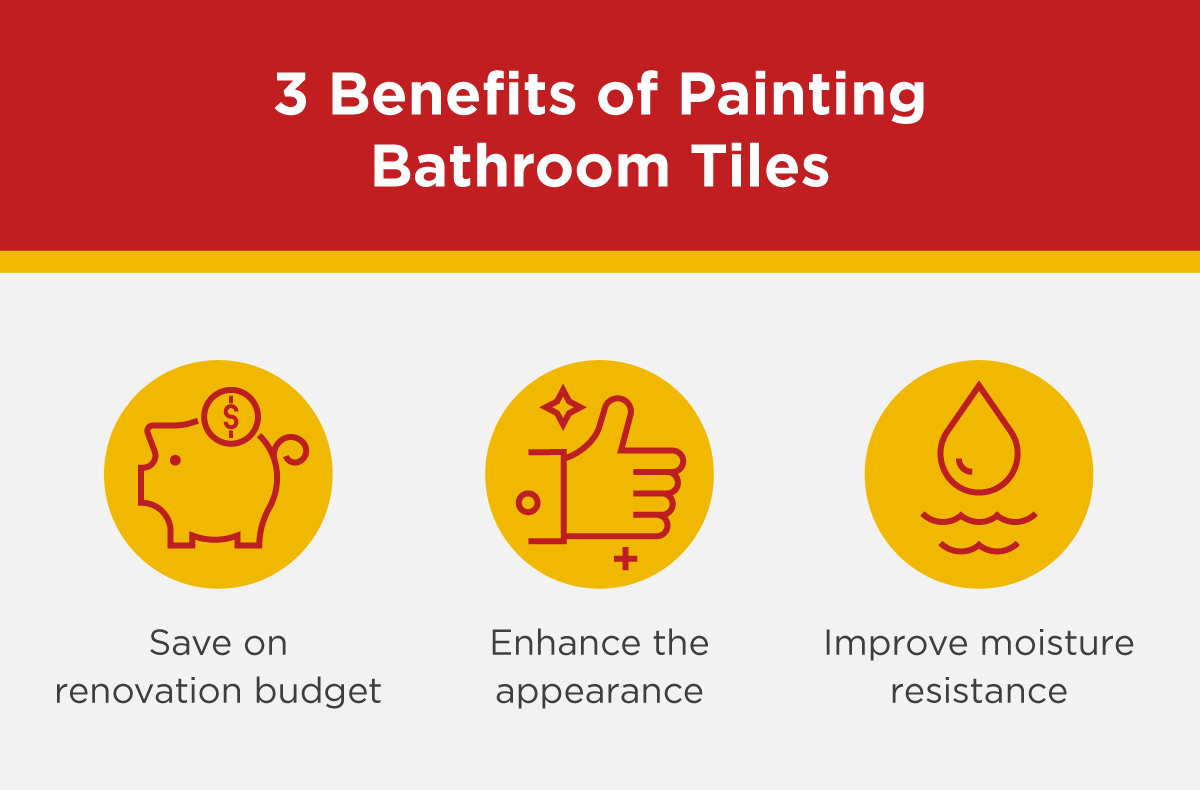Can You Paint Bathroom Tile? A Guide To Upgrading Your Bathroom

|
Quick answer: Yes, you can paint bathroom tile, but significant prep work is required. You have to consider the type of tile, moisture levels, type of paint, and surface needs. |
Intro:
If your bathroom looks old and dull, you’d be surprised at what a fresh coat of paint can do. Considering caulk and various tile surfaces, however, you’re probably wondering if painting bathroom tile is even possible. The answer is yes, you can paint bathroom tiles. You’ll just need to follow specific steps along the way to ensure your paint job comes out looking great..
This post will walk you through the process of painting your bathroom tiles to help you get the result you want. However, if you don’t want to deal with the hassle, there is another option. Hiring an experienced professional like Mr. Handyman® to paint your bathroom tiles will save time and effort and ensure the job is done right.
Types of Paint To Use for Bathroom Tiles
When it comes to painting tile floors, your paint choice will depend largely on the type of tile in your bathroom and the purpose it serves. The top paint options for bathroom tile, depending on the needs of the space, include:
- Latex paint: This is the best choice for ceramic, porcelain, or unglazed quarry tile because it has water-resistant properties. Latex paint is better for bathroom tile that remains relatively dry.
- Epoxy paint: This also has good water resistance and is a top choice for ceramic, porcelain, or unglazed quarry tile. Use epoxy paint on areas that are regularly exposed to moisture, especially one designed for tubs and tiles.
- Acrylic latex paint: This type of paint is water-based and made of acrylic resins. It works well on tile made of natural stone.
Keep in mind that you'll need to use a primer on the tile before painting begins. The primer will help the paint stick to the tile better.

How To Paint Bathroom Tile in 4 Steps
If you decide to take on the task of painting bathroom tile yourself, you’ll need the following tools and materials for the job:
- Paint of choice (latex, epoxy, or acrylic latex)
- Paint primer
- Roller paint brushes and tray
- Handheld paintbrush
- Painter’s tape
- Sandpaper
- Scrubbing brush
- Bathroom/tile cleaner
- Caulk
- Rubber gloves
Once you’ve gathered the necessary materials, follow these steps to ensure your project is a success.
Step 1: Prep
Before painting tiles, it’s important to first prep the tile surface. Grime, cracks, and other issues on the tile surface can prevent the paint from sticking properly. So, before applying any paint, be sure to clean, sand, and repair cracked tile first.
When sanding and scrubbing, make sure you cover the entire area you intend to paint, including grout lines. This means getting rid of any residue or stains that have built up on the tile surface over the years. Give the tile a final scrub to rinse off any soap or residue with warm water.
Step 2: Prime
Once the tile surface is completely dry, use painter’s tape to cover corners and any other areas that don’t need primer or paint.
The type of primer you use will depend on the type of tile you’ll be painting. Use epoxy or urethane primer for ceramic or porcelain tile, while masonry primer is best for natural stone or unglazed quarry tile. Apply a layer of the primer on the tile using a roller brush. Allow the primer to completely dry for several hours.
Step 3: Paint
Use a handheld paintbrush to apply paint around edges, grout, and other areas of the tile that a roller can’t reach. Next, follow the same method as the primer with a separate roller brush to apply an even coat of paint across the tiles. Allow this first coat of paint to fully dry (possibly overnight) before applying a second coat.
You may need to apply a third coat of paint to achieve the desired look. If so, repeat the same process, allowing the second coat to completely dry before applying the last layer of paint. If you’re unsure how many coats you’ll need or run into difficulty with the application process, consider contacting a service professional.
Step 4: Protect
Since most bathrooms tend to be a high-moisture environment, your painted tiles will likely need a clear sealer as the final coat. If you notice any of the paint blistering, peeling, or fading, immediately apply touch-ups followed by a final coat of sealer to protect it.

Is Painting Bathroom Tiles Better Than Replacing Them?
In general, painting your bathroom tile is easier and cheaper than replacing them. When you factor in the time, labor, and cost to replace old tile, you could spend a few thousand dollars, depending on the size of the space.
Unless your bathroom needs tile repair, applying a fresh coat of paint is much more cost-effective, not to mention an easy way to make an old bathroom feel new again. This is especially true for tub and shower areas, which can be even more expensive to retile. Plus, when you choose to paint tile instead of replacing it, you’re free to change the color of the tile as you please.
If your intention is to give your bathroom a completely new design, there’s still a way to achieve this without breaking the bank. For example, you can create your own new patterns for the bathroom floor. This can be a great way to flex your artistic skills and have a little fun in the process.

Get Painting Help From Mr. Handyman
Now that you have all the information you need to successfully paint your tile, the next step is mapping out a few days in your schedule to do it. If painting your tile sounds like a great idea but you just don’t have the time, Mr. Handyman offers professional interior painting services to get the job done for you.
We can paint your tile with the color of your choice and select the right paint to ensure maximum durability and protection from moisture. If you have any questions or would like to learn more about our bathroom tile painting service, give us a call or request an appointment online today!
This article is intended for general informational purposes only and may not be applicable to every situation. You are responsible for determining the proper course of action for your home and property. Mr. Handyman is not responsible for any damages that occur as a result of this blog content or your actions. For the most accurate guidance, contact your local Mr. Handyman location for a comprehensive, on-site assessment.
Tile Painting FAQs
Mr. Handyman has been helping homeowners repair, maintain, and enhance their spaces for over 25 years! We are the one-stop solution for everything on your to-do list. This includes answering your questions about home repairs, maintenance, and improvements. Here are answers to some of your most frequently asked questions about painting tile.
Can you grout after painting tiles?
Yes, you can regrout the tile surface after painting it for a cleaner, even look. Be aware that regrouting the entire bathroom can take days to complete and fully dry.
How long does painting tiles last?
When done properly, painted bathroom tiles can last for several years. High-traffic areas, however, may need touch-ups every couple of years for minor chips and scratches.
Can you use peel-and-stick tile in a shower?
Yes, but this type of tile is not ideal long term. While many peel-and-stick tiles are water-resistant, they’re not waterproof and may gradually lose their adhesive in wet areas.
Is painting bathroom tiles a good idea?
If you’re on a budget, a new paint job is an easy way to refresh your bathroom. However, if most of your tile requires repairs, replacement may be the better option.
 Click to call
Click to call


